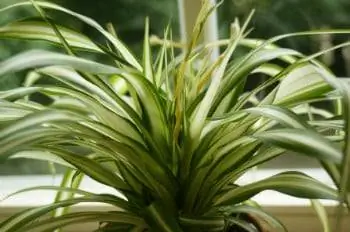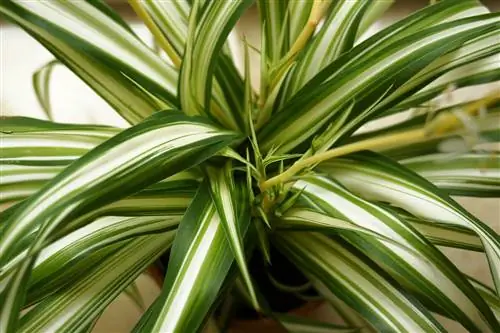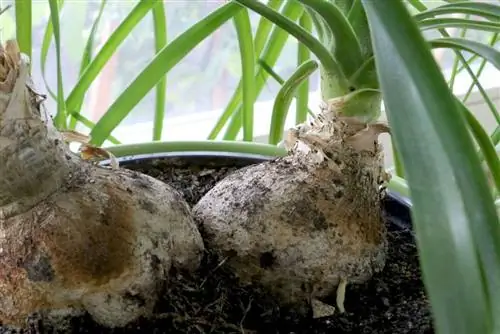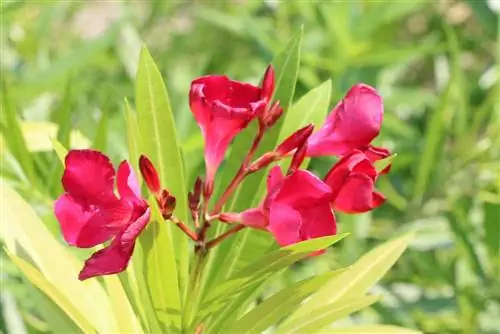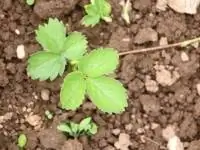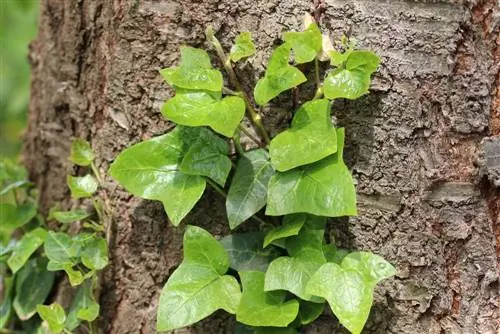- Author admin [email protected].
- Public 2023-12-17 03:39.
- Last modified 2025-01-24 12:45.
Anyone who likes plants usually enjoys propagating them themselves. This is particularly easy with spider plants because they form numerous offshoots all by themselves. And the plants are also decorative and are well suited for beginners as they do not have particularly high demands. Spider plants are perfect beginner plants and are ideal for offices as they not only tolerate many unfavorable conditions, but can also filter pollutants from the air. The spider plant is considered a fairly undemanding plant, but it does not like midday sun. The plant feels particularly at home in hanging baskets and can easily be propagated from the constantly growing offshoots even by inexperienced hobby gardeners. The robust plant was a little out of fashion for a while, but is now enjoying growing popularity again.
Short profile
- Botanical name: Chlorophytum comosum
- other names: official grass, official palm
- belongs to the subfamily of the agave family (Agavoideae)
- clump-forming, perennial herbaceous plant
- narrow leaves between 20 and 40 cm long
- plain or striped versions
- hanging, inconspicuous inflorescences up to 75 cm long
- Capsule fruits (rare in cultivation)
- Houseplant, ornamental foliage plant
Occurrence and species
The spider plant, botanically Chlorophytum comosum, belongs to the subfamily of agave plants within the asparagus family. It originally comes from South Africa and has grown wild in many tropical and subtropical areas. We have had civil servant grass as a houseplant for over 150 years. While the leaves of all wild forms of spider plants are completely green, there are also varieties of cultivated varieties with green-white or green-yellow striped leaves.
- Chlorophytum comosum: very similar to the wild form, green leaves throughout
- Chlorophytum comosum 'Variegatum': leaves with white stripes in the middle, most popular form
- Chlorophytum comosum 'Bonnie': leaves with white stripes, strongly curled
- Chlorophytum comosum bichetii: also called 'Ocean', light green foliage with white edge
- Chlorophytum comosum 'Pictuarum': yellow stripe in the middle of the leaves
Care instructions
Below you will find extensive care instructions for the spider plant as a houseplant.
Location
Caring for the spider plant starts with choosing the right location. It likes it warm and bright, but can also easily burn if exposed to direct sunlight at midday through a pane of glass. If the spider plant is too dark, it will only grow very slowly and its leaves will slowly lose their intense color.
- Light requirements: sunny to partially shaded
- at the window, preferably without midday sun
- East or west windows are perfect
- on a south window behind a curtain
- Shading by other plants also possible
Tip:
Due to its growth habit, the spider plant is also very suitable as a hanging basket plant. It looks particularly decorative when its offshoots hang down to the side.
Air purification
If you often spend time in closed rooms and still want to breathe pollutant-free, fresh air, you should share your apartment or office with houseplants. But not with just any plants, but with those that specialize in absorbing pollutants. Chlorophytum comosum is known for its ability to dramatically reduce formaldehyde concentrations indoors.
Substrate
Green lilies are very undemanding when it comes to the substrate. It should only be well permeable for the irrigation water and not produce waterlogging. It is therefore advisable to mix normal potting soil with a part of sand. If you produce compost in your garden, you can put a small part of it underground, then no additional fertilization will be necessary the following year.
Pouring
Like many other plants that originally come from the dry areas of Africa, the spider plant does not need much water. However, since it cannot store moisture, it must be watered regularly (but cautiously). As a rule, it is enough to water them once a week with a little water. The otherwise robust plant cannot tolerate waterlogging. If the roots are in water, they quickly rot and the plant dies. If the spider plant doesn't get enough water, you can easily tell by the brown tips of the leaves. In these cases, watering should be done a little more frequently. It is best to drain the excess water into a saucer. In the planter, small pebbles or shards of pottery protect the spider plant from “wet feet”.
Tip:
If you have forgotten to water your spider plant for a long time, it is best to give it a dip so that the dry earth can soak up water again.
Fertilize
The spider plant is also rather reserved when it comes to nutrient consumption. It gets along well with a sandy, humus-rich substrate and only needs additional fertilization if it was last repotted into fresh soil at least a year ago. Plants that receive fresh soil every year do not need any additional nutrients at all. Only if the official grass is left in the same substrate for a longer period of time will the nutrients be used up at some point and the plant needs additional fertilizer. This can either be administered via irrigation water or as a long-term fertilizer using a fertilizer stick. The administration of liquid fertilizer is only necessary in spring and summer - i.e. during the active growth phase - and only every four weeks.
Repotting
Green lilies only need a larger pot if the old pot is well rooted and is slowly becoming too small for the ball. The robust plant can also get by with relatively little soil if it is occasionally fertilized via irrigation water. But you shouldn't wait too long before repotting, because if the spider plant grows in the same container for years, the strong roots can definitely break up a ceramic pot. In addition, the roots can no longer be removed from the old pot without damage.
- the new pot just needs to be a little bigger
- Substrate: normal potting soil mixed with a little sand
- Drainage layer made of gravel or expanded clay
Cutting
Green lilies grow quite luxuriantly with appropriate care. However, they do not require pruning. Depending on the variety, the slightly overhanging leaves can be between 20 and 40 cm long. If individual leaves wilt or turn brown, they can be easily plucked out. If the plant suffers from a lack of water, the tips of the leaves will dry out. These can easily be cut off with scissors. If you have small children or pets, you should also cut the flowers before seed capsules form, as the seeds are slightly poisonous.
Tip:
Cut dry leaf tips at an angle, this looks more natural.
Propagate
The particularly popular variegated varieties of spider plants do not form seeds. The plants must therefore be propagated vegetatively. Vegetative propagation produces daughter plants that are genetically identical to the mother plant. Such propagation is very easy with Chlorophytum comosum, because the plant produces a large number of offshoots, so-called children, after a very short time. These kindles form on long flower shoots and sink downwards as the weight increases. The young plants usually develop their first roots on the mother plant.
offshoot
The spider plant offshoots grow from the flowering shoots of the mother plant when it has reached a certain size. The right time to separate the children is when they have already formed at least five leaves of their own. It is even better to wait until the offshoots form their own roots, because in this case they can be planted directly into fresh substrate. Frequently removing the buds does not harm the spider plant. This measure will encourage it to grow more strongly. The offshoots do not necessarily have to be removed. Many hanging children look particularly pretty in a hanging basket.
- Separate offshoots with a sharp knife
- plant directly into the substrate if the roots are at least 2 cm long
- Substrate: standard soil or peat growing substrate with sand
- place weakly rooted offshoots in water
- the head has to stick out from the top
- roots form quickly at around 20 degrees
- plant from a root length of 3 cm
Alternatively, the offshoot can remain on the mother plant and be planted in a pot with substrate. If the young plant is able to survive independently, the connection to the mother plant dries out.
Tip:
Warmth promotes root formation, so the plants should not be placed directly on a cold windowsill. A Styrofoam plate keeps the roots nice and warm.
Division
If the vigorous spider plant becomes too large over the years, the plant can be divided when repotting.
- Time: all year round
- only divide older, large plants
- Removing the plant from the pot
- Untangling roots from each other
- if possible, do not cut
- Avoid major injuries to the roots
- plant both parts in fresh substrate
- water lightly
Wintering
During the winter months, the water requirement of the spider plant is reduced again. The plant should only be watered when the top layer of soil has already dried out. Fertilizer is completely avoided during this time. If the spider plant is in an unheated hallway, it must be protected from frost and cold drafts. Cool temperatures of up to around 5 degrees do not affect the spider plant; from 10 degrees it stops growing and enters a resting phase. But she doesn't necessarily need this.
Diseases and pests
Like most houseplants, spider plants occasionally suffer from scale insects or aphids. The animals usually attack plants in the winter months when they are weakened by the warm air from the heating system. In this case, rinse the plant with lukewarm water and spray it with soapy water or nettle broth. It is also good for the plant if it is placed in a bright but slightly cooler room.
Care errors
Although the spider plant is very robust and forgives some care mistakes, the plant is not indestructible.
Green lily leaves turn light
This bleaching of the leaves is usually due to an unsuitable location. If the plants are in the bright midday sun behind a south-facing window, the leaves can easily burn and appear colorless. Too little light also leads to the loss of the stripes on the leaves. In both cases, a change of location is recommended.
Green lily gets brown leaf tips
If dried, brown tips form on the leaves, this is usually an indication of too little moisture. Dry air or too little irrigation water can be the cause here. In winter, the spider plant should therefore not be placed directly above a heater and should be sprayed frequently. If there is a lack of water, of course, only more frequent watering will help, but the plant should under no circumstances be drowned.
Conclusion
The outstanding features of the spider plant are quickly explained: undemanding and easy to care for. It is one of the classic beginner plants and is also very popular in offices to bring a little green into the room. The spider plant forgives almost all care mistakes, only waterlogging and blazing midday sun bother it.
Care tips in brief
A plant from the spider plant family has very low demands on lighting conditions, water supply or fertilization and with just a few attentions gives its owner a lot of joy.
the ideal location:
- sunny
- Penumbra
- Shadow
- On the windowsill or in the winter garden
- In summer, the plants on the terrace or even in the bed can form a nice contrast to other garden plants
- If left in direct sunlight for too long, the leaves can burn
Temperatures:
- Cool to warm
- If the location is very warm with sun, occasionally mist the spider plant with the water pollinator
- The plant stops growing below 10 degrees Celsius
- The Mediterranean plant cannot tolerate frost
Watering, depending on location heat and sunlight:
- normal to a lot
- no waterlogging
- If the bale is dry, immerse it and let the water drip off
Fertilization:
- with fertilizer for house or balcony plants
- from spring to autumn once or twice a week
- In winter, when the plant stops growing, refrain from fertilizing

